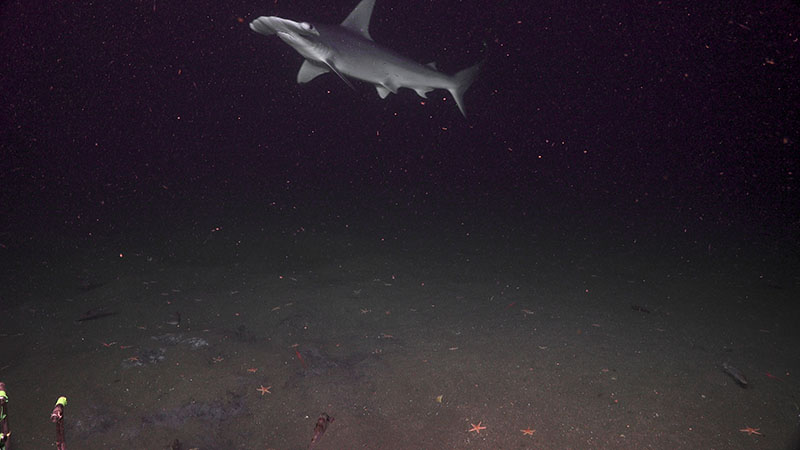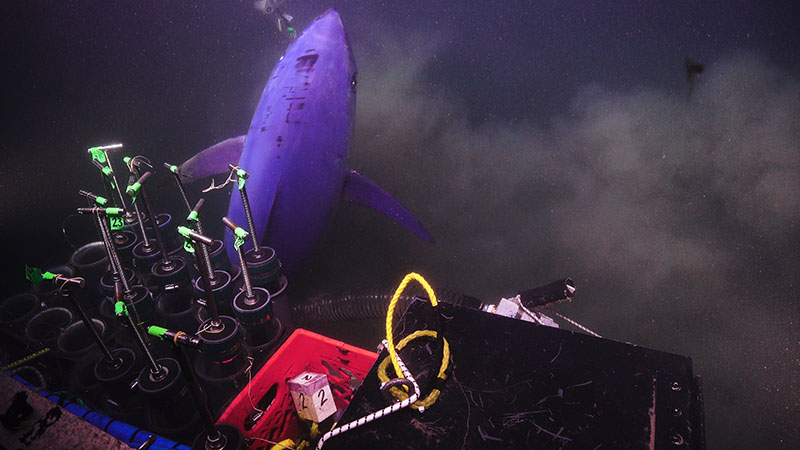
By Caitlin Adams, Operations Coordinator, NOAA Office of Ocean Exploration and Research
With the end of the expedition in sight, Team DEEP SEARCH has been extremely busy spending our last full week at sea doing as much science as possible. After Monday’s mega-dive at Pamlico Canyon, we were back in the water no more than 5 hours later at Pea Island Seep. We spent 12 hours on the bottom overnight, and recovered midday on Tuesday.
We first visited Pea Island Seep back in 2017 with autonomous underwater vehicle (AUV) Sentry and dove on it last year with human occupied vehicle (HOV) Alvin, so we were confident we’d again find the bacterial mats that are commonly associated with these methane seep habitats. With remotely operated vehicle (ROV) Jason’s full suite of cameras mounted on every face of the vehicle, we were able to observe even more of the habitat there—including some megafauna like a hammerhead shark and a manta ray that seemed to trail just behind the vehicle for much of the dive! We also had a school of fish follow us most of the time, and we regularly saw other animals like blackbelly rosefish and crustaceans (king crabs and lobsters) along the seafloor.

This school of fish followed ROV Jason for much of the dive at Pea Island Seep. Image courtesy of Ivan Hurzeler and DEEP SEARCH 2019 - BOEM, USGS, NOAA, ROV Jason, ©Woods Hole Oceanographic Institution. Download larger version (jpg, 4.2 MB).

These blackbelly rosefish were observed throughout the dive at Pea Island Seep. Image courtesy of Ivan Hurzeler and DEEP SEARCH 2019 - BOEM, USGS, NOAA, ROV Jason, ©Woods Hole Oceanographic Institution. Download larger version (jpg, 4.5 MB).
It was our first seep dive of the cruise, which meant a big change in post-dive processing for the science team. Instead of bioboxes and coral quivers filled with coral samples to be photographed, snipped, and preserved for each of the coral scientists to take back to their labs with them, the ROV was filled to the brim with push cores—32 in all! Push cores are more processing-intensive than some of the other samples we take: both the Demopoulos and Joye labs must spend many hours sectioning, sieving, and otherwise analyzing the cores before they have the sub-samples they need to take home with them.
With our next site, Kitty Hawk Seep, just a couple hours steam away from Pea Island, there was no way everyone would have been done processing before the next dive—but that’s why you pack extra sampling gear. The mud teams kept processing the samples from Pea Island while the ROV went back in the water at 8pm on Tuesday for yet another overnight dive. We shifted around ROV watch schedules a bit to make sure that the mud folks had time to keep processing and hopefully sneak in some sleep, too. Those of us who aren’t official mud lab members also made sure to pitch in where we could—we might not be benthic ecologists or sediment geochemists, but we can surely hold the cores steady while someone else processes them or hand wash the core equipment before it goes back on the ROV!

Bacterial mats like these were found at both Kitty Hawk and Pea Island seeps. Image courtesy of Ivan Hurzeler and DEEP SEARCH 2019 - BOEM, USGS, NOAA, ROV Jason, ©Woods Hole Oceanographic Institution. Download larger version (jpg, 4 MB).

This hammerhead shark followed behind the ROV for much of the dive at Kitty Hawk Seep but was only seen once in the forward-facing science camera. Image courtesy of Ivan Hurzeler and DEEP SEARCH 2019 - BOEM, USGS, NOAA, ROV Jason, ©Woods Hole Oceanographic Institution. Download larger version (jpg, 4.1 MB).
The Kitty Hawk Seep dive revealed similar habitats to those at Pea Island: lots of bacterial mats, carbonate rocks, fish, crabs—and we even had a yellowfin tuna confront the ROV for a couple minutes while we were trying to collect some push cores! We brought back a similarly large load of samples (push cores and rocks) from Kitty Hawk, and we’ll be busy processing those for the next day or two, all the while balancing our shipboard processing schedule with our ambitious dive schedule until the cruise wraps up next Tuesday.

Push core sampling at Kitty Hawk Seep was interrupted at one point by a yellowfin tuna! Image courtesy of Ivan Hurzeler and DEEP SEARCH 2019 - BOEM, USGS, NOAA, ROV Jason, ©Woods Hole Oceanographic Institution. Download larger version (jpg, 4.2 MB).

Team DEEP SEARCH even observed a small colony of Lophelia pertusa growing on a sediment-covered rock at Pea Island Seep. Image courtesy of Ivan Hurzeler and DEEP SEARCH 2019 - BOEM, USGS, NOAA, ROV Jason, ©Woods Hole Oceanographic Institution. Download larger version (jpg, 3.8 MB).